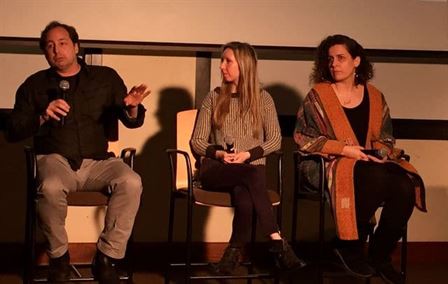
Nate Hamlin (L), Kiira Benzing (M) and Stina Hamlin (R) speak at the virtual reality panel in University Hall.
Julia Siegel | The Montclarion
The Film Institute at Montclair State University and the Montclair Film Festival brought their annual “Behind the Screen” event to University Hall on Sunday, Jan. 29. The all-day event featured six professional workshop panels, open to the public and students, that discussed the inside scoop on different aspects of the entertainment industry. The panel topics included writing for late-night comedy, virtual reality, television and film directing, television editing, interactive storytelling and crowdfunding.
Glenn Eichler, a writer for “The Late Show with Stephen Colbert,” discussed the multitude of jokes one needs to be able to write in order to be a late-night writer. He described the different categories of late-night comedy, like the cold open, monologue, desk piece, field piece, guest sketch, roll-in and interview. Every late-night show uses these seven types of jokes to keep the audience engaged.
“The monologue…is probably the most important [part] of the show,” Eichler said. He went on to say that it is the most important because hosts have to show the audience that they are aware of newsworthy topics. The monologue is also written every day, and cannot be written in advance due to the timeliness needed for comedic success.
Another important part of writing for late-night is the guest sketches, which have the potential to go viral through social media if executed properly. Eichler explained that celebrities love doing sketches because it gives them a break from the routine interview and gives them a chance to be funny. Even though the celebrity gets to be funny, Eichler stressed that the host of the show still needs to get more punchlines. He referred to Liam Neeson as a good example of someone to write a sketch for because Neeson is a serious actor, so you would not expect him to be funny.
Besides being able to write various types of comedy, Eichler said that the single most important part of writing comedy is being able to write a great punchline. A good joke moves from the setup to the punchline quickly. Eichler said that comedy writers count words and syllables to keep a joke short, sweet and to the point. Rhythm is also key to creating a good joke. If you can put it all together, then you can succeed in comedy writing.
Eichler said that “punching-up a joke” is the “highest-pressure part of the day.” He continued, “We have no polished gems in late night.” Eichler explained that a day in the life of a writer is so busy that the ability to quickly revise jokes is a must.
Another panel showed how entertainment professionals from multiple disciplines are finding new ways to tell stories with emerging technology. The virtual reality panel featured Kiira Benzing, Stina Hamlin and Nate Hamlin. It was moderated by Professor Beverly Peterson.
Peterson announced that the new School of Communication and Media will feature a makerspace for students to create and experiment with new ideas. The university will also be launching a virtual reality course this fall. The panelists discussed how technology is constantly changing, and providing new ways for filmmakers to engage with their audiences.
Many people may not know that the 360-degree cameras used to create virtual reality videos have been on the market for years. These types of videos were not readily available for the public to view until YouTube launched its 360 channel in 2015.
Nate Hamlin said, to make a compelling video, you need an all-immersive subject that interests you. He stressed that you need to think about whether 360-degree cameras are needed to tell a story, and about what ways you want your audience to view the video prior to shooting. Benzing said that the relationship to the content changes based on how it is viewed. She explained that virtual reality is meant for “exploring an environment as if you are there.”
Hamlin discussed how catering to people’s senses can help make a successful video.
“Sound is such an important part because it is immersive,” she said, explaining that sound can trigger reactions to the content and help a viewer make sense of what they are seeing. Benzing went on to say that there are no rules for editing or even creating virtual reality experiences currently because the technology is still emerging. She loves that she can play with the field and find what works best for her. She stressed that virtual reality is such an open medium and that anyone can learn how to tell stories in whatever way they want to.
Benzing is also excited for the feature of the field. When asked what the next “big thing” in the field would be, she replied that mixed reality, a combination of virtual (VR) and augmented reality(AR), would be the next medium to explore. “Blending AR and VR is very exciting,” she said.
The big takeaway from the virtual reality panel was that whether you come from a theater, film, television, news, documentary or camera-operating background, you can get involved with virtual reality. The panelists also said that if you want to try virtual reality for yourself, there are two great places in New York City to go to. The Bowery disctrict’s Jump Into the Light arcade and Brooklyn’s VR Bar are virtual reality arcades where you can play with all the different types of headsets.


